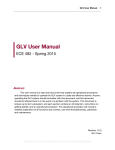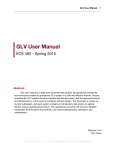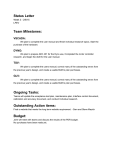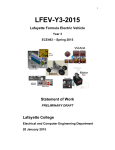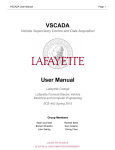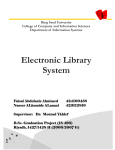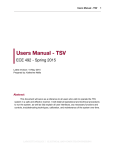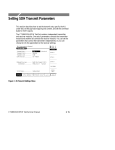Download GLV ATP Draft - Sites at Lafayette
Transcript
GLV Systems Test Plan 1 Abstract This document details the acceptance test plan for the Grounded Low Voltage system being developed for the LFEV design project. This is only a test plan draft, and will be replaced by a more specific document in the future. Revision 1.0.0 LAFAYETTE COLLEGE │ ELECTRICAL AND COMPUTER ENGINEERING GLV Systems Test Plan 2 GLV Team Table of Contents Abstract Table of Contents Summary GLV Power T1.0: Max Voltage Test T1.1: Tractive System Powerup Test T1.2: GLV Failure Test T1.3: Hot Terminal Insulation Test T1.4: 5R to Ground Test T1.5: GLV Power Test T1.6: Battery Duration Test T1.7: Battery Charging Test T1.8: PlugandForget Test T1.9: ChargefromZero Test It shall be possible to charge a fully discharged GLV battery without disassembly or special actions. Test Procedure: T1.10: Full Discharge Protection Test T1.11: Overcharge Protection Test T1.12: Overcurrent Protection Test T1.12: Overvoltage Protection Test Safety Loop T2.0: Post Automatic Shutdown Test T2.1: Shutdown Circuit Test T2.2: Master Switches Test T2.3: Shutdown Buttons Test T2.4: Brake OverTravel Switch Test T2.5: Safety Ratings Test Tractive System Interface T3.0: TSAL Test T3.1: TSVP Test T3.2: VSCADA Relay Control Test T3.3: Load Controller Power Test T3.4: Insulation Monitoring Device Test T3.5: Isolation Relay LED Test T3.6: TSMP Test VCI T4.0: Ready to Drive Sound Length Test LAFAYETTE COLLEGE │ ELECTRICAL AND COMPUTER ENGINEERING GLV Systems Test Plan 3 T4.1: Ready to Drive Sound Tone Test T4.2: Voltage to Load Sensor Test T4.3: Current to Load Sensor Test T4.4: Power to Load Sensor Test T4.5: System Temperatures Sensors Test GLV General Requirements Tests T5.0: Electrical Insulation Test T5.1: Prohibited Insulators Test T5.2: Fuse Current Test T5.3: Fuse Voltage Test LAFAYETTE COLLEGE │ ELECTRICAL AND COMPUTER ENGINEERING GLV Systems Test Plan 4 Summary The grounded low voltage system (GLV) being designed and developed in the LFEV project is intended to power all of the vehicle’s elements, except for the tractive system. To verify the operation of the GLV system, the following subsystems must be designed and tested: ● GLV Power : This system is responsible for powering all aspects of the vehicle except for the tractive system. The power system must run on a rechargeable battery and last for at least three hours. ● Safety : This system runs the shutdown circuit and safety loop. If any device detects a failure, or if a user engages a shutdown button, the system will shut down according to the procedure outlined in the EV. ● Tractive System Interface (TSI) : This system acts as an interface between the tractive system voltage and the grounded low voltage. Specifically, it is responsible for requirements associated with galvanic isolation, the insulation monitoring device (IMD), the tractive system active light (TSAL), and the TSV load controller. ● Vehicle Computer Interface (VCI): This system acts as an interface between the VSCADA software and the rest of the vehicle. Specifically must interface vehicle sensors and the system computer. LAFAYETTE COLLEGE │ ELECTRICAL AND COMPUTER ENGINEERING GLV Systems Test Plan 5 GLV Power The GLV Power subsystem provides power to all of the nontractive systems in the electric vehicle. This includes the rest of the GLV system, TSV AIRS, VSCADA computer, Motor, and Motor Controller. The Power subsystem consists of a Power Box, which houses the battery and a Power Monitor. This Power Box has a Charging Port, circuit breaker, and multiple LEDS. The following tests will be performed to demonstrate that GLV Power meets all requirements: T1.0: Max Voltage Test The GLV System may not have a voltage greater than 30VDC. Test Procedure: 1. Demonstrate compliance using the data for the battery used to power the GLV System. This will be a 24VDC battery. Thus, voltages above that will not be created. 2. Measure the upper voltage limit on the overvoltage protector in the Power Monitor circuit. This voltage will be 25V, indicating that higher voltages will not pass through this safeguard. 3. Measure the voltage on either side of the GLV battery. This voltage should be at 24VDC. according to the spec and the battery data sheet. This location will have the highest voltage of the GLV system. Acceptance Threshold : 1. The battery will be a 24VDC battery. 2. The threshold voltage for the overvoltage protection will be 25VDC. 3. The measured voltage at the output of the battery will be below 25VDC. T1.1: Tractive System Powerup Test The GLV system must be powered up before it is possible to activate the tractive system (see EV4.7). Test Procedure: 1. Ensure that the GLV Power is not active. For this test, turn off GLV Power at the GLV Master Switch. 2. Attempt to power up the tractive system. The TSV battery packs cannot turn on without the GLV Power being on. 3. Turn on GLV Power. Use the GLV Master Switch. 4. Power up the tractive system. There should be no issues turning on the tractive once the GLV Power system is active LAFAYETTE COLLEGE │ ELECTRICAL AND COMPUTER ENGINEERING GLV Systems Test Plan 6 Acceptance Threshold: 1. The tractive systems are not able to power up when the GLV Master Switch is not closed (steps 1 and 2). 2. The tractive systems power up once the GLV Master Switch is closed (steps 3 and 4). T1.2: GLV Failure Test A failure causing the GLV system to shut down must immediately deactivate the tractive system as well. Test Procedure: 1. Turn on GLV Power. 2. Turn on the tractive system power. 3. Deactivate the GLV Master Switch. The tractive systems should immediately deactivate. Acceptance Threshold: 1. The tractive system deactivates immediately after the GLV Master Switch is turned off. T1.3: Hot Terminal Insulation Test The hot (ungrounded) terminal must be insulated. Test Procedure: 1. Demonstrate compliance through inspection. Photographs will be included in the ATR. Acceptance Threshold: 1. The hot terminal is insulated. T1.4: 5R to Ground Test All accessible parts of the vehicle containing conductive material (e.g. coated metal parts, carbon fiber parts, etc.) which might contact a damaged wire or electrical part, no matter if tractive system or GLV, must have a resistance below 5 ohm to GLV system ground. Test Procedure: 1. Use an Ohmmeter to test the resistance from GLV ground to conductive parts of the vehicle. If the car is assembled, the chassis can be probed for system ground. If not, the grounded terminal of the battery will need to be used. The main focus of this test for GLV will be the metal boxes housing the GLV subsystems. 2. Measure the resistance from GLV ground to the metal Power Box. 3. Measure the resistance from GLV ground to the Cockpit Controls Box. LAFAYETTE COLLEGE │ ELECTRICAL AND COMPUTER ENGINEERING GLV Systems Test Plan 7 4. Measure the resistance from GLV ground to both Side Controls. 5. Measure the resistance from GLV ground to the TSI Box. Acceptance Threshold: 1. All of the measured resistances are 5 Ohm or less. T1.5: GLV Power Test The GLV system shall provide DC supply voltage with sufficient current to supply all the power needs of the GLV systems and other nontractive systems. Test Procedure: 1. Use analysis to determine the power needs of all vehicle nontractive systems. Demonstrate that the battery can output a current high enough to fulfill those power needs. This should be done using the battery spec as well as actually measuring current output from the battery. 2. Contingent upon the progress of the other groups, use the GLV battery to power all other GLV systems and other nontractive systems. This step can be done in conjunction with T1.6. Acceptance Threshold: 1. The analysis determines/demonstrates that battery output is capable of supplying all the power needs of nontractive systems. 2. The GLV battery successfully powers the nontractive systems that are ready at the time of testing. T1.6: Battery Duration Test The GLV system shall contain a rechargeable battery of sufficient capacity to run the car GLV systems for at least three hours. Test Procedure: 1. Use analysis to determine the power consumption of all nontractive systems in the electric vehicle. Show with mathematics that the battery capacity is large enough to output enough power for at least three hours of use. 2. Contingent upon the progress of the other groups, use the GLV battery to power all other GLV systems and other nontractive systems for longer than three hours. Ideally, power all GLV systems for as long as possible. If a system is not ready at the time of testing, simulate its existence by adding a load of equal power consumption to the system. Acceptance Threshold: LAFAYETTE COLLEGE │ ELECTRICAL AND COMPUTER ENGINEERING GLV Systems Test Plan 8 1. The analysis determines/demonstrates that battery output is capable of supplying all the power needs of nontractive systems for three hours. 2. The GLV battery successfully powers the nontractive systems for three hours. T1.7: Battery Charging Test The GLV system shall be rechargeable by means of a UL listed charging device that plugs into the 120 VAC mains. Test Procedure: 1. Demonstrate UL compliance with proof from online that the charger is UL listed. 2. Plug that charger into the 120 VAC wall socket and charge the battery. Acceptance Threshold: 1. The charger is UL listed. 2. The charger works using the 120 VAC source. T1.8: Plug-and-Forget Test The charging system shall be capable of powering the GLV system indefinitely as it simultaneously charges the GLV battery in a plug and forget functionality in a manner similar to typical laptop computers or cell phones. Test Procedure: 1. Plug that charger into the 120 VAC wall socket and charge the battery. 2. Use the battery to power the nontractive systems on the car while the battery is charging. 3. Monitor the state of charge of the battery to determine that the charge is increasing as it is being simultaneously charged and used. Acceptance Threshold: 1. The battery can still be used to power the necessary systems when charging. 2. The state of charge must increase while being charged and used simultaneously. If the power consumption is larger than the power gained from charging, then the charging system is not capable of powering the GLV system indefinitely . LAFAYETTE COLLEGE │ ELECTRICAL AND COMPUTER ENGINEERING GLV Systems Test Plan 9 T1.9: Charge-from-Zero Test It shall be possible to charge a fully discharged GLV battery without disassembly or special actions. Test Procedure: 1. Fully discharge the GLV battery. This can be done with a simulated load if there are not systems in place that can utilize the GLV power. It is necessary that the GLV Power Box is in its completed state; it must include the battery and all power monitoring devices. 2. 2. Plug the charger into the 120 VAC wall socket and charge the battery. Acceptance Threshold: 1. The battery successfully charges after being fully discharged. 2. No disassembly or special actions are required to charge the battery. T1.10: Full Discharge Protection Test The GLV battery shall be protected from full discharge. Test Procedure: 1. Measure the input voltage for the lower voltage limit of the undervoltage protection in the Power Monitor. This voltage should be 20 VDC. 2. Attach the Power Monitor to an external power supply in series with a resistive load. 3. Monitor output voltage as the voltage is lowered from 23V to 19V. Acceptance Threshold: 1. The lower limit threshold voltage input is 20 VDC. 2. The undervoltage protection does not allow voltages below 20 VDC to pass. T1.11: Overcharge Protection Test The GLV battery shall be protected from overcharge. Test Procedure: 1. Use online data for the charger to determine compliance with this requirement. The charger must have a feature that cuts off power automatically when the battery pack is fully charged. Acceptance Threshold: 1. Compliance is demonstrated through inspection. LAFAYETTE COLLEGE │ ELECTRICAL AND COMPUTER ENGINEERING GLV Systems Test Plan 10 T1.12: Overcurrent Protection Test The GLV battery shall be protected from overcurrent. Test Procedure: 1. Attach the circuit breaker being used for overcurrent protection to a separate power supply in series with a 0.5 Ohm resistor. 2. Increase voltage to 3.5 V and slightly higher if need be. 3. The circuit breaker should pop at 7A. 4. Cut power and reset the circuit breaker. 5. Demonstrate that the circuit breaker passes current after being reset. Acceptance Threshold: 1. The circuit breaker does not allow more than 7A to pass. 2. The battery is rated for a current higher than 7A (likely 10A). T1.12: Overvoltage Protection Test The GLV battery shall be protected from overvoltage. Test Procedure: 1. Measure the input voltage for the upper voltage limit of the overvoltage protection in the Power Monitor. This voltage should be 25 VDC. 2. Attach the Power Monitor to an external power supply in series with a resistive load. 3. 3. Monitor output voltage as the voltage is raised from 23V to 26V. Acceptance Threshold: 1. The input voltage for the upper voltage limit is 25 VDC. 2. The overvoltage protection does not allow more than 25 VDC to pass through the Power Monitor. LAFAYETTE COLLEGE │ ELECTRICAL AND COMPUTER ENGINEERING GLV Systems Test Plan 11 Safety Loop The Safety Circuit and Safety Loop are designed to keep the high voltage system in a safe operational state via constant monitoring of each individual electrical subsystem. The Safety Loop flows throughout the system while the Safety Circuit exists in the TSI Box. The following tests will be performed to demonstrate that the Safety Loop meets all requirements: T2.0: Post Automatic Shutdown Test The precharge circuit must operate regardless of the sequence of operations used to energize the vehicle, including after automatic safety shut down. Test Procedure: 1. Follow the steps listed in the User’s Manual to find the source of failure within the Safety Loop. 2. Reset the vehicle as per the User’s Manual 3. Check to see that the precharge circuit is operational. Acceptance Threshold: 1. This circuit will need to function after any automatic shutdown situation. This test will be passed when the vehicle shows this functionality after an automatic shutdown. T2.1: Shutdown Circuit Test All of the current flowing to the AIRs is supplied by the Shutdown Circuit and, when opened, should shut down the tractive system. Test Procedure: 1. Refer to T2.2, T2.3, and T2.4 to understand how the shutdown circuit is opened. 2. Check to see that the AIRs have no current and the tractive system is shutdown in any one of the above scenarios. Acceptance Threshold: 1. Safety is paramount so there is no acceptance threshold for the shutdown circuit. This circuit must perform under all circumstances. If there is a failure, a Master Switch flipped, or Emergency Button pushed, the circuit must open and shut down the tractive system along with the electrical systems depending on the scenario. LAFAYETTE COLLEGE │ ELECTRICAL AND COMPUTER ENGINEERING GLV Systems Test Plan 12 T2.2: Master Switches Test The Master Switches are required to be placed and oriented on the vehicle and be able to disabled the electrical circuits of the car (GLVMS) and the tractive system (TSMS) directly. Test Procedure: 1. Obtain two rotary type switches with removable red key. One for the GLV and one for the TS. 2. Design the circuits such that all power to electrical circuits flow directly through the GLVMS and that the TSMS opens the shutdown circuit. 3. Show securely mounted switches on the right side of the car, labeled, next to each other and orient them such that “ON” is parallel to the foreaft axis of the car. Acceptance Threshold: 1. The preliminary circuit design and designs from previous years account for the specific use of the switches. We will follow accordingly and make sure the Master Switches directly terminate electrical system function and tractive system function (depending on the switch). 2. Mounting and orientation of the Master Switches is a physical attribute and will be performed in the Mechanical Engineering design of the car. T2.3: Shutdown Buttons Test Each of three pushrotate BRBs opens the shutdown circuit and kills the tractive system. The side mounted BRBs also kill all electronics. Test Procedure: 1. Obtain three pushrotate buttons were pushing the button directly opens the shutdown circuit. One button on each side of the vehicle (40mm) at the level of the drivers head, and one button in the cockpit (24mm). 2. Push any of the buttons to separate the tractive system from the accumulators. The side buttons will also shut down all electrical systems. Check status lights to ensure each button functions in this way. 3. Be able to press the cockpit button no matter where your (the drivers) hands are and no matter the orientation of the wheel. 4. If the driver pushes this button (with nothing else wrong), have the driver rotate this button to close the shutdown circuit and perform an additional action (undecided) to make the vehicle readytodrive again. 5. Try removing the shutdown buttons from the car. Acceptance Threshold: LAFAYETTE COLLEGE │ ELECTRICAL AND COMPUTER ENGINEERING GLV Systems Test Plan 13 1. The shutdown button test will be passed if each of the buttons disabled the tractive system and, depending on which button, the electrical systems as well. 2. The buttons are the appropriate sizes, and are appropriately mounted and secured to the vehicle. T2.4: Brake Over-Travel Switch Test The BOTS shuts down the tractive system by opening the shutdown circuit. Test Procedure: 1. Flip the BOTS and check the status of the tractive system. . Do this manually; not by slamming on the brake pedal itself. 2. Once mounted, have the driver attempt to reset the BOTS him/herself. Acceptance Threshold: 1. This test will be passed when the tractive system is successfully disabled by the BOTS and is out of reach of the driver. T2.5: Safety Ratings Test All electrical safety items are rated for (at least) the maximum tractive system voltage. Test Procedure: 1. Items purchased should be checked against the maximum tractive system voltage and purchased only if they are up to such specifications. 2. Check the most uptodate BOM to see that listed parts are up to specifications. Acceptance Threshold: 1. Only if safety items meet the requirement of their rating exceeding the maximum tractive system voltage will this test be passed. LAFAYETTE COLLEGE │ ELECTRICAL AND COMPUTER ENGINEERING GLV Systems Test Plan 14 Tractive System Interface The Tractive System Interface includes all low voltage circuits that are connected to the TSV. Most of these circuits are contained within the Load Controller box and the following tests will be performed to demonstrate that the TSI meets all requirements: T3.0: TSAL Test The tractive system active light needs to turn on when there is a voltage of greater than 5V on the high voltage lines, or when the AIRs are closed. Test Procedure: 1. Make sure Load Controller is properly connected to all other systems. 2. Attach the high voltage lines to the high voltage power supply. 3. Keep the AIRs open 4. Increase the power supply voltage from 0 to 10 in increments of 1 volt. Then increase the power from 10 to 100 in increments of 10 volts. 5. Close AIRs and repeat step 4. Acceptance Threshold: 1. When the AIRs are open the TSAL should be on when the power supply voltage is over 5 volts. 2. When the AIRs are closed the TSAL should always be on. T3.1: TSVP Test The tractive system voltage present light must be on when a voltage greater than 30VDC is present outside of the accumulator containers. Test Procedure: 1. Make sure the Load Controller is properly connected to all other systems. 2. Attach the high voltage lines to the high voltage power supply. 3. Make sure AIRs are closed. 4. Increase the power supply voltage from 0 to 100 volts in increments of 10 volts. Acceptance Threshold: 1. The TSVP lights should be on whenever the high voltage power supply is greater than 30 volts. LAFAYETTE COLLEGE │ ELECTRICAL AND COMPUTER ENGINEERING GLV Systems Test Plan 15 T3.2: VSCADA Relay Control Test The VSCADA system should be able to open and close the isolation relays located in the load controller. Test Procedure: 1. Set up a multimeter to measure the connectivity between the two terminals of each isolation relay. 2. Turn on load controller power 3. Close the relays using the VSCADA interface 4. Open the relays using the VSCADA interface Acceptance Threshold: 1. The multimeters should indicate that both terminals for each isolation relay are connected when the relays are closed 2. The multimeters should indicate that both terminals for each isolation relay are not connected when the relays are open. T3.3: Load Controller Power Test Low voltage power should be present in the load controller when the power switch is in the on position. Test Procedure: 1. Put the power switch in the off position. 2. Make sure the GLV power box is correctly connected to the load controller. 3. Set up a multimeter to measure the voltage present at J14 pin on the DIN Rail. 4. Put the power switch in the on position. Acceptance Threshold: 1. In the off position there should be no voltage present at the J14 pin and the pilot light should be off. 2. In the on position there should voltage present at the J14 pin and the pilot light should be on. T3.4: Insulation Monitoring Device Test This is a specific test that is outlined in the EV rules and will be done during the Electrical Tech Inspection. Test Procedure: LAFAYETTE COLLEGE │ ELECTRICAL AND COMPUTER ENGINEERING GLV Systems Test Plan 16 1. Make sure the load controller is powered and there is voltage present at the TSV side of the isolation relays. 2. Use a 250 ohm/v resistor to connect the tractive system to each of the individual boxes in the GLV system. 3. Using a stopwatch, record the time between initial contact and complete system shut down. Acceptance Threshold: 1. The recorded time must be below 30 seconds for each box. T3.5: Isolation Relay LED Test The isolation relay LEDs indicate when each isolation relay is closed. Test Procedure: 1. Make sure the power switch is in the on position and the pilot light is on. 2. Using the VSCADA interface, open both of the isolation relays. 3. Using the VSCADA interface, close both of the isolation relays. Acceptance Threshold: 1. When the isolation relays are closed, the corresponding LED should be on. 2. When the isolation relays are open, the corresponding LED should be off. T3.6: TSMP Test The tractive system measuring points are two outlets that allow the voltage at the positive and negative motor controller supply lines to be easily measured. Test Procedure: 1. Connect the high voltage lines to the high voltage power supply. 2. Put the power switch in the on position and make sure the pilot light is on. 3. Set up a multimeter to measure the voltage at the positive and negative motor controller supply lines. 4. Set up a multimeter to measure the voltage present at the TSMPS. 5. Increase the power supply voltage from 0 to 100 volts at increments of 10 volts and record the reading on both multimeters. Acceptance Threshold: LAFAYETTE COLLEGE │ ELECTRICAL AND COMPUTER ENGINEERING GLV Systems Test Plan 17 1. The voltage measured at the TSMPs should always be within 2% of the voltage at the measured at the high voltage power lines. LAFAYETTE COLLEGE │ ELECTRICAL AND COMPUTER ENGINEERING GLV Systems Test Plan 18 VCI The Vehicle Computer Interface will deliver data from sensors located throughout the car to the VSCADA system. Data from theses sensors will be converted from analog to digital data using microprocessors and then formated for the cockpit display by the VSCADA computer. The Ready-to-Drive sound speaker will also be designed and implemented as a safety feature for the electric car. The following tests will be performed to demonstrate that the VCI meets all requirements: T4.0: Ready to Drive Sound Length Test The car must make a characteristic sound, for a minimum of 1 second and a maximum of 3 seconds, when it is ready to drive. Test Procedure: 1. Set the car into ready to drive mode. 2. Use a stopwatch to time the length of the sound that is emitted by the speaker. Acceptance Threshold: 1. The sound must last between one second and three seconds. T4.1: Ready to Drive Sound Tone Test The emitting device must produce a tone of approximately 2500 to 3500 Hz with a minimum loudness of 68 dB(A) at 2 ft. One device that meets this requirement is the Mallory Sonalert SC648AJR11. Test Procedure: 1. Set the car into ready to drive mode. 2. Measure the loudness of the Ready to Drive sound at a distance of two feet. 3. Measure the frequency of the tone. Acceptance Threshold: 1. One way to prove compliance is to buy the suggested speaker. 2. Otherwise, the loudness is above 68 dB(A) at two feet, and te frequency is between 2500 and 3500 Hz. LAFAYETTE COLLEGE │ ELECTRICAL AND COMPUTER ENGINEERING GLV Systems Test Plan 19 T4.2: Voltage to Load Sensor Test Overall voltage delivered to the load must be monitored and stored by VSCADA. The VCI subsystem of GLV must collect this data and convert it from analog to digital. Test Procedure: 1. Read the digital output after the A2D of for the voltage measurement being supplied to the battery from the load. 2. Measure this value with a multimeter. 3. Compare the results. Acceptance Threshold: 1. The measurements must be consistent within 0.2VDC. T4.3: Current to Load Sensor Test Overall current delivered to the load must be monitored and stored by VSCADA. The VCI subsystem of GLV must collect this data and convert it from analog to digital. Test Procedure: 1. Read the digital output after the A2D of for the current measurement being supplied to the battery from the load. 2. Measure this value outright. 3. Compare the results. Acceptance Threshold: 1. The measurements must be consistent within 100mA. T4.4: Power to Load Sensor Test Overall power delivered to the load must be monitored and stored by VSCADA. The VCI subsystem of GLV must collect this data and convert it from analog to digital. Test Procedure: 1. This test can be done using mathematics and the previous two tests. Thus, perform tests T4.2 and T4.3 to determine the measured voltage and current delivered to the load. 2. Determine the power being supplied using P=VI. 3. Read the digital output for the power measurement being supplied to the battery from the load. 4. Compare the results. LAFAYETTE COLLEGE │ ELECTRICAL AND COMPUTER ENGINEERING GLV Systems Test Plan 20 Acceptance Threshold: 1. The measurement and calculation must be consistent within 20mW. T4.5: System Temperatures Sensors Test Temperatures of ambient, all subsystems, significant fuses or other devices that may heat up normally or as a result of an anticipated fault must be monitored and stored by VSCADA. The VCI subsystem of GLV must collect this data and convert it from analog to digital. Test Procedure: 1. Read the digital output after the A2D of for the temperature measurements relating to various locations throughout the system. 2. Use a standalone temperature measuring device to measure these temperatures outright. 3. Compare the results. Acceptance Threshold: 1. The measurements must be consistent within one degree. LAFAYETTE COLLEGE │ ELECTRICAL AND COMPUTER ENGINEERING GLV Systems Test Plan 21 GLV General Requirements Tests The following tests demonstrate compliance for requirements that do not fit into one specific GLV subsystem: T5.0: Electrical Insulation Test All electrical insulating materials must be UL recognized and be temperature rated for either 90C or the maximum expected operating temperature at the location of use (whichever is higher). Test Procedure: 1. Demonstrate UL compliance by providing evidence that the insulating material is UL recognized. 2. Provide evidence that the insulating material is rated for the required temperatures. Acceptance Threshold: 1. The electrical insulating materials are UL recognized. 2. The data sheet for the material confirms the material is rated for the required temperatures. 3. There are reliable sources online that confirm the material is rated for the required temperatures (not necessary if threshold 2 is met). T5.1: Prohibited Insulators Test Vinyl electrical insulating tape and rubberlike paints and coatings are not acceptable electrical insulating materials. Test Procedure: 1. Prove compliance by inspection. Acceptance Threshold: LAFAYETTE COLLEGE │ ELECTRICAL AND COMPUTER ENGINEERING GLV Systems Test Plan 22 1. This is a zerotolerance threshold. There must be absolutely none of the listed prohibited insulators used. T5.2: Fuse Current Test The continuous current rating of a fuse must not be greater than the continuous current rating of any electrical component, for example wire, busbar, battery cell or other conductor that it protects. All fuses must have an interrupt current rating which is higher than the theoretical short circuit current of the system that it protects. Test Procedure: 1. Prove compliance by inspection. Document current ratings and interrupt current ratings of all fuses in the system. 2. Prove by analysis that the ratings are sufficient. Acceptance Threshold: 1. All current ratings meet spec. T5.3: Fuse Voltage Test All fuses and fuse holders must be rated for the highest voltage in the systems they protect. Fuses used for DC must be rated for DC, and must carry a DC rating equal to or greater than the system voltage of the system in which they are used. Test Procedure: 1. Prove compliance by inspection. Document voltage ratings for fuses and fuse holders. 2. Compare these voltages to 25 VDC. Acceptance Threshold: 1. Fuses and fuse holders are rated for higher than 25 VDC. The battery should not output a voltage higher than 24 VDC, but the overvoltage setting is 25 VDC. LAFAYETTE COLLEGE │ ELECTRICAL AND COMPUTER ENGINEERING






















